
Have you ever had one of those moments when everything you thought was true turned on its head? Researching this review wasn’t one of those moments, but I was nevertheless shocked to find out that Subaru’s BRZ had outsold Toyota’s 86 by almost 10 percent in 2018, and as of last November’s close was ahead by a staggering 150 percent.
If you weren’t already aware, Toyota’s 86 and the previous Scion FR-S always found many more buyers than Subaru’s version of this compact sport coupe. No matter whether being sold under the less known Scion brand or while wearing Toyota’s famed double-oval logo, it’s success just came down to the sheer number of bodies flowing in and out of Canada’s second-best-selling automaker’s dealerships, whereas Subaru is 13th on Canadian sales charts and therefore could never have as many potential buyers enter its establishments. Still, the comparatively tiny all-wheel drive specialty brand is literally beating Toyota at its own two-wheel drive game.
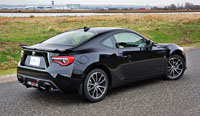
This could be due to the BRZ being a medium-sized fish in a little pond, compared to the 86 that’s more of a minnow trying to get noticed in an ocean of much more popular Toyota product. Certainly the BRZ is no big seller for Subaru either, but consider for a moment that the 86 represents just 0.1 percent of the 200,041 Toyotas sold in Canada over the past 11 months, compared to the BRZ that was a much more significant 1.2 percent of the 52,853 Subarus sold during the same period, and it’s easy to see why it might garner a bit more importance in a Subaru retailer’s lineup.
As it is, the 86 has seen its sales decline at a rapid rate over the past couple of years. Since it first arrived on the Canadian scene in 2012, resulting in 1,470 deliveries within its initial seven months, its popularity has plunged from 1,825 units in 2013, to 1,559 in 2014, 1,329 in 2015, 988 in 2016, 919 in 2017, and finally 550 in 2018, while year-to-date it’s only sold a scant 250 units. This represents a 53.3-percent drop over the same 11 months last year, while the BRZ’s 625 deliveries over the same duration shows an 8.1-percent increase.
Of course, the BRZ isn’t the 86’ only competitor, just its most obvious being they’re identical cars below very similar skins. Mazda’s MX-5, which sold 767 units so far this year, resulting in 26.99 percent year-over-year growth, joins the BRZ by showing there’s some renewed interest in the entry-level sports car segment as long as the updates focus on the needs and desires of its uniquely passionate customer base.
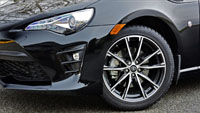
The fact is, the 86 hasn’t been updated since its 2017 model year refresh and concurrent Scion FR-S transformation, other than some special editions, and as to the importance of updating aging models, its sales numbers speak for themselves. So what’s going to happen to this beloved sports car in the near future? That’s anyone’s guess, and we shouldn’t rely wholly on the words of a U.S.-market Toyota spokesperson who told us last year that the 86 was here to stay for the foreseeable future.
If you think the sad state of 86 sales is merely a problem for Toyota Canada, consider that the 3,122 units delivered in the U.S. market over the past 11 months also represents about 0.1 percent of Toyota’s total 1,913,159 unit output up until November’s end, so the car merely exists to improve Toyota’s performance branding, and I think the new 2020 Supra will do a much better job of that this year.
Nevertheless, Toyota hasn’t completely forgotten its most affordable sports car, the 2020 86 soon to arrive with a 0.9-inch larger 7.0-inch infotainment touchscreen featuring a revised interface capable of Apple CarPlay and Android Auto smartphone integration plus more, but before I get into that, let’s talk about this 2019 model and the changes made three years ago.
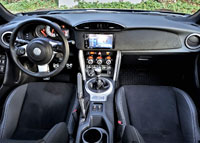
Toyota updated the 86’ frontal design for the 2017 model year, with new standard LED headlights, revised front fender vents positioned lower on the side panel with a new “86” insignia, and a fresh set of taillights featuring brighter LED technology. The interior, which has always been quite nice for this class, was made more easily accessible via available proximity keyless entry, while the ignition could be started and stopped with a button. Additional upgrades included optional two-zone automatic climate control, leather and Alcantara upholstery, with the suede-like material also topping the primary instrument hood and passenger-side dash insert.
The 2019 86 continues forward with a Toyota-branded 6.1-inch centre touchscreen featuring attractive blue on black patterned graphics, all the normal radio functions, USB integration, plus Bluetooth phone and audio connectivity, although fans that hoped to find the backup camera’s image on the main display were disappointed (including yours truly) to find it still projected from within the rearview mirror. This makes the mirror less useful, and being that the camera’s display is so small, it becomes a double negative when trying to reverse on a rainy night. Of course, Toyota will remedy this problem when the new larger 2020 infotainment system arrives, correct? No, unfortunately that touchscreen is bigger and functionality more complete, but it won’t be used for reversing purposes.
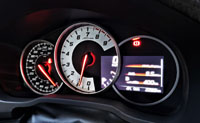
I’m forced to point back to the North American sales figures noted earlier, but I can’t say for sure whether or not they’d increase significantly if Toyota made the 86 more practical. I’d guess that it would be nigh impossible to cover the increased costs of integrating a rearview camera within the centre display for the 6,200 year-to-date 86 and BRZ models sold into our two countries (the only two global markets that mandate backup cameras), so we’re left with this half-measure to satisfy the requirements of legislators. All I can say is, 15 minutes of fast-paced shenanigans down a circuitous mountainside pass and you won’t care one whit about backing up.
Did you notice I said “down” a mountainside pass? That’s due to the 86’ Subaru-sourced 2.0-litre “boxer” four-cylinder engine, which once again makes just 205 horsepower and 156 lb-ft of torque for 2019. Don’t get me wrong as I personally find this wholly adequate, particularly when tooling around town or flinging this little sensation down a winding road, as it weighs in at just 1,252 kg (2,760 lbs) and therefore doesn’t need a whole lot of power. Still, its ardent fan-base has been calling out for more engine output for years, and those steadily falling sales numbers might mean that those prospective buyers are right. Toyota pumped up horsepower and torque by 2.5 and 3.3 percent respectively for 2017, but that obviously didn’t get anyone excited, so the automaker may want to lean on Subaru to give up its new 268 horsepower 2.0-litre turbocharged WRX engine, or better yet the 310-hp 2.5-litre WRX STI mill.
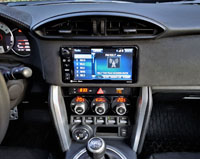
Actual 86 output was increased by five horsepower and five lb-ft of torque for 2017, which while slightly improved only represented a respective 2.5 and 3.3 percent more beef added to a very lean, near vegan diet, so therefore it didn’t answer the continual online petition from the model’s faithful for much more performance.
Notably, only six-speed manual equipped 86s get the power upgrade, which also joined a revised rear differential tuned for quicker standing starts. Also available is a six-speed automatic with paddles shifters, complete with rev-matched downshifting that works very well as experienced in my 2017 86 tester, but as just mentioned it only gets the old 200 horsepower engine with 151 lb-ft of torque. On the positive both cars were upgraded with hill start assist in 2017, which certainly helps when taking off in hilly areas.
I enjoyed the automatic a lot more than I first expected to, particularly when driving around the city, but being that the 86 is a serious rear-wheel drive sports car designed for enthusiasts, unlike the ever-shrinking class of compact car-based front-wheel drive sporty coupes available, I’d only personally consider the manual.
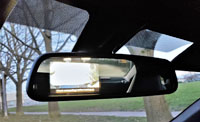
After all, modulating the clutch while letting the engine revs climb up to 7,000 rpm for max power is the optimal way to eke the most performance from the engine’s available power, no matter if you’re pulling away from a stoplight or quickly exiting a curve, while that last point in mind the 86 remains one of the best ways to quickly snake through a serpentine canyon road or equally curvaceous ribbon of tarmac anywhere else.
MacPherson gas struts are positioned under the hood up front while double wishbones take care of the fully independent rear suspension, while it’s possible to move up from my tester’s most luxurious GT trim to a manual-only TRD Special Edition (or SE) model hiding SACHS performance dampers behind its upgraded Brembo brakes and one-inch larger 18-inch alloys wrapped in 215/40R18 Michelin Pilot Sport 4 performance rubber. My tester would’ve normally worn 215/45R17 summers, but Toyota smartly swapped those tire out for a set of Bridgestone Blizzak winters that actually made it more fun to slide sideways mid-turn.
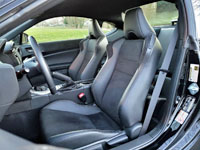
Speaking of trims, the 2019 86 can be had as a base, GT or just-mentioned SE, with some thus-far not mentioned entry-level base highlights including a limited slip differential, auto on/off LED headlights, heatable power-remote outside mirrors, remote entry, a tilt and telescoping leather-clad multifunction three-spoke sport steering wheel, a leather-wrapped shift knob and handbrake lever, aluminum sport pedals, a trip computer/multi-info display, cruise control, variable intermittent windshield wipers, one-zone automatic HVAC, an eight-speaker AM/FM audio system with auxiliary and USB ports plus an Automatic Sound Levelizer (ASL), Bluetooth phone and streaming audio, a six-way manual driver’s seat, power windows with auto up/down, dual vanity mirrors, all the expected active and passive safety features and more for only $29,990 (plus freight and fees).
The auto transmission costs $1,200 extra, which is the same whether opting for a base 86 or my $33,260 as-tested GT tester. GT trim wasn’t on the menu when I reviewed the 2017 86, by the way, but most of its features were part of a Special Edition that now shares its more performance-oriented upgrades with the top-line SE trim noted a moment ago. Before I delve into that TRD special, I should point out that GT trim adds the proximity keyless entry and pushbutton ignition system I noted earlier, plus the dual-zone auto climate control and more luxurious leather and microsuede upholstery I spoke about, while its front seats add heaters as part of this package, with additional GT upgrades including LED fog lights, a rear spoiler, a 4.2-inch TFT multi-information display showing performance data, and theft deterrence.
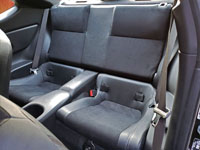
Finally, the $38,220 SE trim, or more specifically the TRD (Toyota Racing Development) Special Edition adds black side mirror housings, a cool TRD aero kit, a TRD performance dual exhaust upgrade, unique cloth sport seats with sporty red accents, red seatbelts, and red stitching throughout the cabin, plus the wheel/tire and suspension mods noted before.
Trims, packages and pricing in mind, 2019 86 buyer are able to access up to $2,000 in additional incentives right now. Just go to our 2019 Toyota 86 Canada Prices page right here at CarCostCanada to learn more, but then again if you really want the upgraded infotainment system (CarPlay and Android integration can be helpful) then check out the 2020 Toyota 86 Canada Prices page, which will show you how to benefit from factory leasing and financing rates from 3.49 percent. Both pages provide complete pricing information as well as info about manufacturer rebates and dealer invoice pricing that could save you thousands.
Toyota replaces the TRD Special Edition with a new Hakone Edition for 2020, which features special Hakone Green paint and rolls on unique 17-inch bronze-coloured alloy wheels; the name reportedly paying tribute to “one of the greatest driving roads in the world,” or so says Toyota.

One thing that shouldn’t change from 2019 to 2020 is fuel economy, the 86 rated at 9.9 L/100km city, 7.3 highway and 8.7 combined when fitted with its manual, or 11.3, 8.3 9.9 respectively with its autobox. While not best in the sports car class, it’s still pretty decent for anything that drives as well as it does.
This said most buying into this class won’t give a rat’s derriere about fuel-efficiency, but when compared to some rivals that only offer two front seats the 86’ rear bench might come in handy, and importantly its single-piece rear seatback folds flat in order to extend the reasonably sized 196-litre (6.9 cubic-foot) trunk, which I’ve actually seen filled up with four racing slicks on wheels (a beautiful sight).
A new 86 would certainly make one wonderfully reliable weekend racer, not to mention a great way to get to work and back. All for less than $30k? Yes, it should sell a lot better than it does.
Story and photo credits: Trevor Hofmann
